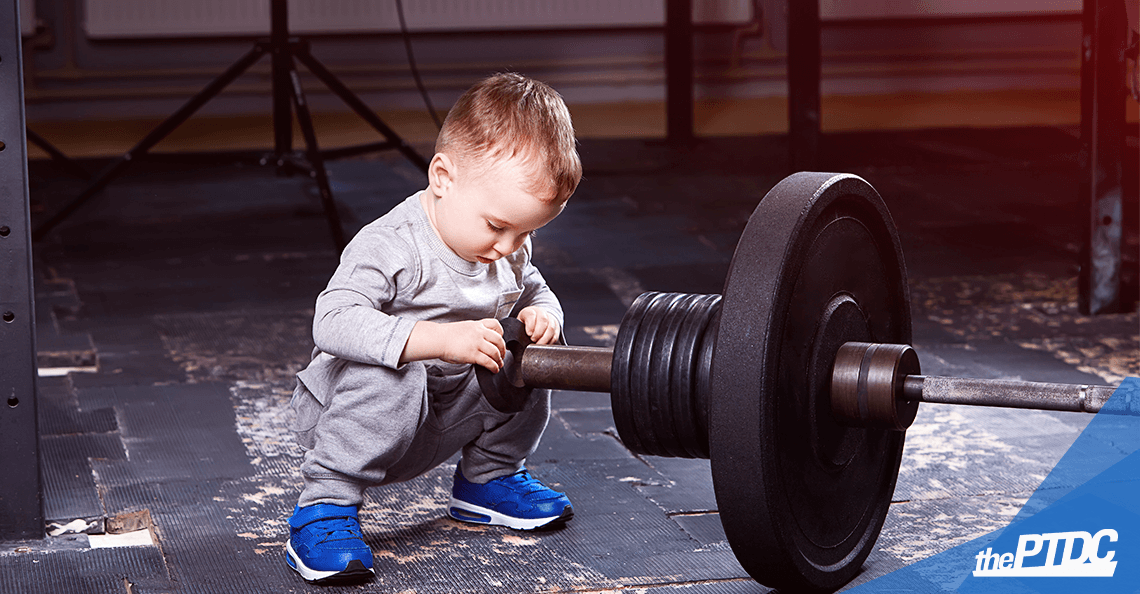Some parents smile at the thought of having their kids in the gym. Others cringe—gym time is their time, away from the kids!
Trainers might love it or hate it. Same with gym members—for every indulgent smile, there’s a glare.
Me? I love it.
I think of 8-year-old Olivia, who often comes to her mom’s weekly workouts at our gym in Edmonton. Olivia will watch us, then read, then watch some more—and sometimes jump up to give her mom, Lisa, a hug.
For two years now, Olivia has been watching her mom squat, deadlift, press, curl, stretch—all of it, and has seen how she’s getting stronger every week.
I’ve watched Olivia grow to become a bright, sweet, smiling (if slightly shy) girl.
At home, her mom reports, Olivia will even join in the bodyweight exercises.
Like I said, I love it. Here’s why:
- Her mom is setting a great example by prioritizing health and wellness.
- Olivia views working out as normal, and the gym as a safe, friendly place. What a beautiful thing!
- For Lisa, a busy professional, bringing Olivia is a convenient alternative to hiring childcare.
- For me, I know Lisa is less likely to miss a workout.
- One more thing, also for me: It’s a joy to have Olivia at our sessions!
I’d like to think everyone has my positive attitude about kids and fitness. But guess what happened when I posted the following on Instagram:
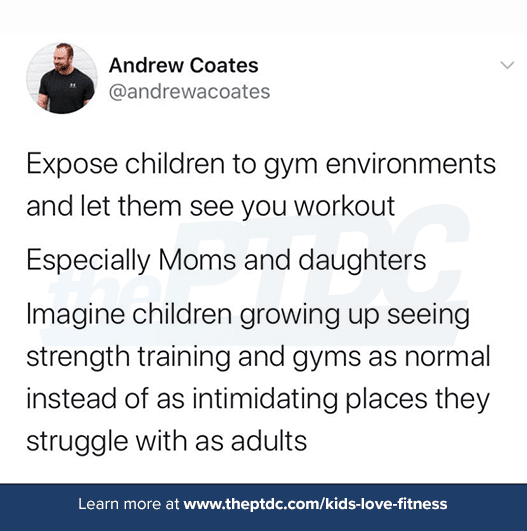
Instagram flagged this as false! Clearly its algorithm was having an overzealous day. If anything, it was the warning from Instagram that was false. But we’re used to this bias against kids—there’s even an old myth that strength training stunts growth. Please.
No wonder gyms are adult territory. Most gyms have an age minimum (13 or 14, usually) for using equipment, and many ban parents from even bringing young children on the floor.
Instead, the kids stay home or are shunted into the gym’s day-care room.
To be clear, many kids don’t want to be in the gym. It can be a noisy, intimidating place, with all the banging and grunting and scary machines. Moreover, they didn’t grow up seeing their parents lift weights. Everything about the landscape is foreign. Which is too bad.
Don’t get me wrong—I know why many people resist the idea of letting children in the gym. It’s a sanctuary, a place to recharge.
A workout is “me time,” a chance to indulge in self-care that boosts emotional wellbeing and energy—which certainly helps anyone become a better parent.
But I suggest you look back into your own past. See how you—and your clients—answer these questions:
- Was your first gym experience as an adult bewildering? Intimidating? Maybe terrifying?
- Did you ever bail on a workout—or even an entire program—out of fear?
- Do you wish you’d started your training at an earlier age, and regret those lost years?
Let’s face it—if we’re going to make progress against obesity, we need to start earlier. Nearly one in five young people (18 percent) worldwide are overweight or obese. That’s 340 million children and adolescents, according to the World Health Organization.
And the numbers get even worse in adulthood.
Here are some more questions, but this time let’s look forward:
- What if we caught kids long before they became obese, inactive, gym-fearing adults?
- What if more children saw strength training as a normal part of life, not a forbidding, grown-up world?
- What if more gyms let kids be there while their parents worked out?
- What if there were fun programs to teach children age-appropriate exercises?
That’s my fantasy future. Children emulate parents, and parents normalize behavior for kids—whether that’s good or bad behavior. Let’s go with good behavior, shall we?
Skills that are imprinted in childhood persist into adulthood. If you played softball as a girl, you can still throw with good form. If you learned how to shoot free throws in junior high, it comes back to you easily in the adult league. Same with skiing, soccer, you name it.
Or I’ll name it: strength training. Imagine a healthier future where young people aren’t intimidated by barbells or a squat rack. Where they love exercise because it has always been part of their lives.
That means fewer people walking into a gym scared. Fewer who feel so uncomfortable there that they remain sedentary and end up on blood pressure meds for the rest of their lives.
How do we create this future? How can we make it easier for clients and members to have young children nearby, where kids are immersed in a world where lifting weights and being active is normal? Let’s go step by step.
8 Ways Personal Trainers Can Get Kids to Love Fitness
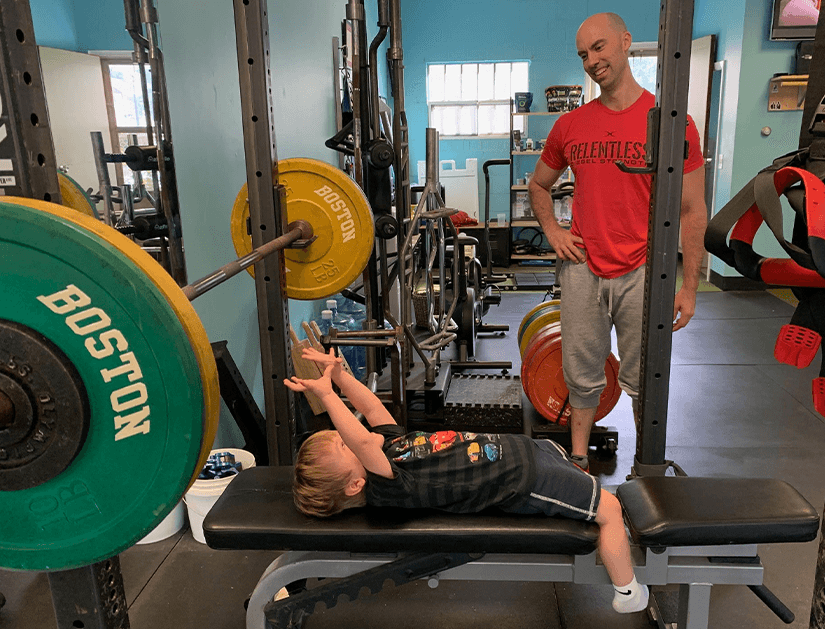
Tony Gentilcore’s son, Julian, has been going to the gym with Mom and Dad since the week he was born. “In the four years since, it’s not uncommon for him to partake in the shenanigans,” Tony wrote on Instagram.
1. Let kids into your fitness facility.
I’m not sure large commercial gym chains will change their no-kids policies, but plenty of smaller places might. Consider it a branding opportunity: Try the only gym in town where your kids are welcome! Or: She’s the trainer who loves kids!
I have a trainer friend at Evolve Strength, Lorelei Rammel, who has held a client’s newborn while the new mom lifted. Lorelei herself returned to work after giving birth and coached with her baby in a carrier. (Talk about imprinting!) Of course, she’s super-careful and limited in her demonstrations. But she makes it work, and everyone’s happy—her, her clients, her baby.
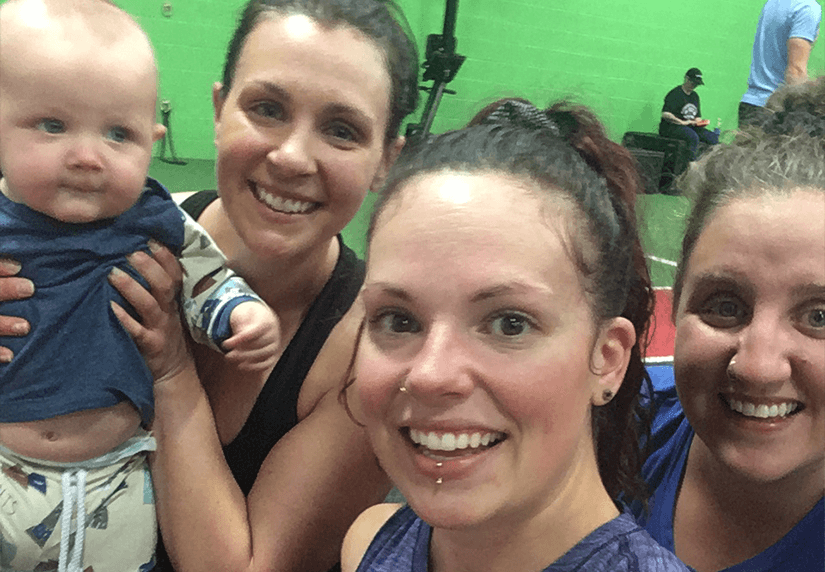
Lorelei Rammel is a trainer at Evolve Strength, where clients are welcome to bring their children.
2. Create fitness programs for preteens.
Nearly all parents want their children to be active. But not all kids are into the traditional school sports. Let’s give those kids something to do (not much hand-eye coordination necessary!).
Obviously, we shouldn’t teach 5-year-olds to deadlift, but the potential for fun workouts is immense. It could be a kids’ bootcamp, or a sport-specific program.
I have some kids in the 10-to-12 range who are into soccer and get plenty of coaching, trust me. My role is to expose them to the gym, teaching them basic, safe movement mechanics, and get them excited about the gym. To that end …
3. Make fitness fun.
We have a generation of kids skipping gym class, so let’s show them how fun it can be outside of school. Sled pushing, farmer’s carries, simple bodyweight moves—these are fun and safe. I never put them under barbells. We don't do presses. But throwing a med ball against the wall with all their might? Now that’s fun!
It’s never too early for correct form—for instance, learning proper lunge mechanics will serve them well throughout life, not just on this summer’s travel team. We teach things they need for sports and for life.
One thing though—resist the temptation to make it a game. Sure, two teams can race pushing a sled. But the built-in reward system of competition can backfire. I want the kids to love exercise for the intrinsic joy of it. Give compliments, not medals.
4. Set an example.
We’re not going to change the world overnight. But you can make a huge difference in your clients’ lives. Look what happened to training supercouple Tony Gentilcore and Lisa Lewis.
Tony, a renowned coach and teacher, and Lisa, a registered psychologist and fitness educator, were indoctrinated into the gym life early—Lisa by her father and Tony “from many repeat viewings of Rambo.” Their toddler, Julian, has gone to the gym with Mommy and Daddy since he was a week old. And now “it’s not uncommon for him to partake in the shenanigans himself,” Tony says.
“It fills our love tank every time we go to the gym as a family and do something active together,” Tony says. “We firmly believe the sentiment will stick with Julian, and that he too will reap all the benefits and lessons a lifetime of iron will inevitably teach him.”
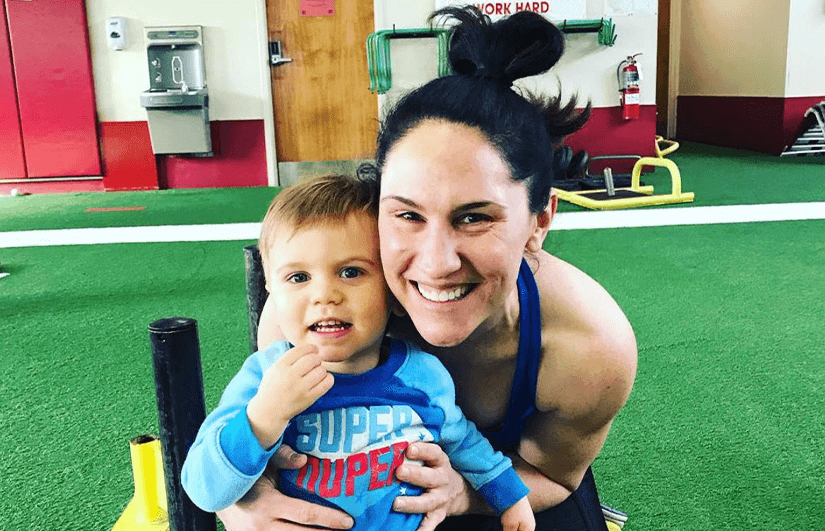
Tony’s wife, Lisa Lewis, with their son, Julian.
5. Sell the benefits.
When Tony and Lisa started competitive sports (he baseball, she volleyball), “we both understood how lifting weights would not only help us perform better,” he says, “but also provide a myriad of other benefits: confidence, injury prevention, improved body composition, and just an overall sense of well-being.”
Tell that to a snowboarding teenager and mention the benefits of squats.
6. Accentuate the (body) positive.
Sadly, young people who could benefit greatly from the gym—heavy kids and skinny kids—are often the most reluctant to set foot in one. Personal trainer, fitness writer and mother Hannah Gray knows this.
She was always active as an adult, but didn’t take up powerlifting and Olympic weightlifting until relatively late in life, and promptly dropped 80 pounds and kicked antidepressants. She’s now a world-class masters weightlifter.
Her older daughter is “built like her mom,” tall and strong. But when she reached junior high, Hannah says, “She felt slow. Fat. She was starting to hate her body because she didn’t look like the other girls on her basketball team.”
Hannah brought her to the gym to “show her that her body was strong and awesome.” She became one of Canada’s top junior weightlifters. “Now, at 17 years old, she is strong and confident and appreciates her body for all the cool things it’s able to do.” Her younger daughter is a rock climber who took up powerlifting “and has noticed the stark difference in how she feels when she trains regularly versus when she doesn’t.”
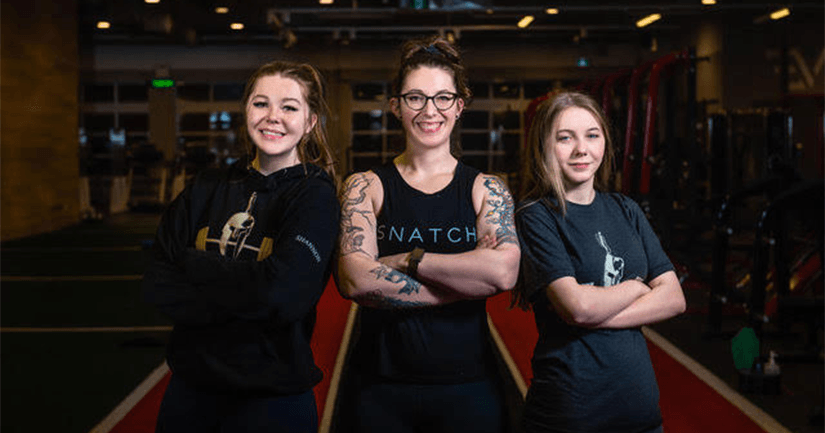
For the Grays, strength training is a family tradition. Mom Hannah Gray is a world-class masters weightlifter, while her older daughter (left) is one of Canada’s top junior weightlifters and her younger daughter (right) is a rock climber who does powerlifting.
7. Have your clients bring their kids.
Your clients probably aren’t fitness professionals with overachieving kids. But we can all nudge society toward wellness, one family at a time. Let’s share our love for the gym. Let’s show them early on the benefits—and fun—of strength training. Let’s make them comfortable in our home away from home. Start by asking the parents at your gym about inviting the kids.
In my experience, parents quickly embrace the option, once they’ve tried it. It may take a little persuasion—moms often put themselves last, thinking “I’m the caretaker; it’s selfish to do something for myself.” So they might skip a workout because they can’t get a sitter.
8. Use common sense.
It’s easy to maintain your gym’s status quo and not allow kids on your floor. Some members might not like having kids around. Fine. Each owner has to decide for her or himself. But don’t let a negative attitude torpedo an opportunity.
Make your own risk-benefit calculation. No swinging on the equipment, kids! That’s common sense. But pushups on the mat in the corner? Sure!
I’m reminded of Jenny Lam, a Toronto-based integrative nutrition health coach and personal trainer who trains a lot of moms virtually in their homes. She encourages them not only to exercise with their children nearby, but suggests using the little ones as weights.
Seriously—try a goblet squat with a baby, or a (very careful) overhead press, or a glute bridge with a young one on your hips. Jenny finds that nobody is more careful with a child than a mom.
And guess what—moms (and dads) are lifting, swinging, and carrying kids all day long with no harm done. They can certainly do that on a mat.


